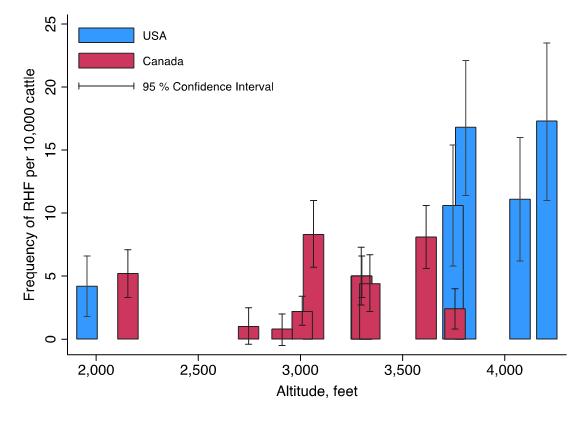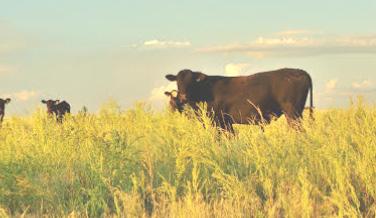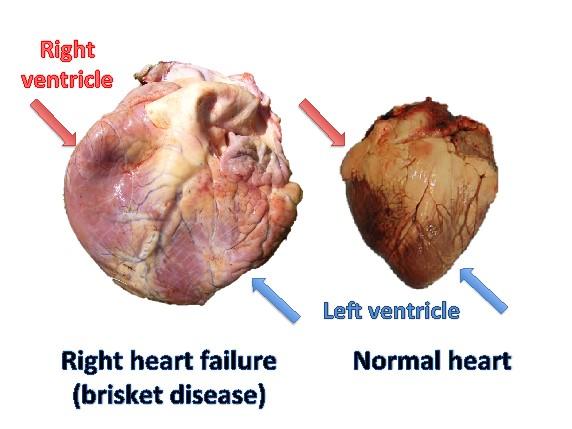
7 minute read
the High Plains
the high country (> 7,000 ft) will typically only keep breeding bulls that have PAP measure less than 45 mm Hg at the altitude at which they are exposed to. Since PAP is moderately to highly heritable,2 the progeny of these bulls should have a lower risk of brisket disease than progeny from sires with a greater PAP measure.

breeding bulls that have PAP measure less than 45 mm Hg at the altitude at which they are exposed to. Since PAP is moderately to highly heritable,2 the progeny of these bulls should have a lower risk of brisket disease than progeny from sires with a greater PAP measure.
Cow-calf producers in the high country have known about brisket disease for many years. The disease was first reported in South Park, Colorado in 1915.3 The disease became known as ‘high altitude disease’ because, up until the 1960s, the disease was only seen at altitudes over 7,000ft.
Cow-calf producers in the high country have known about brisket disease for many years. The disease was first reported in South Park, Colorado in 1915.3 The disease became known as ‘high altitude disease’ because, up until the 1960s, the disease was only seen at altitudes over 7,000ft.
High altitude disease is no longer an appropriate name for this disease because the disease has since been seen to occur at all altitudes–high altitude merely increases the risk (Figure 1).
High altitude disease is no longer an appropriate name for this disease because the disease has since been seen to occur at all altitudes–high altitude merely increases the risk (Figure 1).
So what does this all mean for you, the feedlot producer? It means that congestive heart failure or brisket disease is likely occurring in your yard. Drs. Booker, Morley, Wildman, and I recently conducted an epidemiological study of 10 Canadian and 5 US feedlots located at altitudes ranging from 2,000 to 4,200 ft.4 The study involved approximately 1.6 million cattle over a 12-year period.
So what does this all mean for you, the feedlot producer? It means that congestive heart failure or brisket disease is likely occurring in your yard. Drs. Booker, Morley, Wildman, and I recently conducted an epidemiological study of 10 Canadian and 5 US feedlots located at altitudes ranging from 2,000 to 4,200 ft.4 The study involved approximately 1.6 million cattle over a 12-year period.
We found that the incidence of brisket disease doubled from the years 2000 to 2008. In 2012, 1 per 1,000 feedlot cattle died of brisket disease. To put that in perspective,
We found that the incidence of brisket disease doubled from the years 2000 to 2008. In 2012, 1 per 1,000 feedlot cattle died of brisket disease. To put that in perspective, approximately 4 cattle died of digestive disorders (bloat, approximately 4 cattle died of digestive disorders (bloat, intestinal disorders, enteritis). So, although the death loss from brisket disease in feedlot cattle is relatively small at present, it is not trivial. Furthermore, the majority of the cases occurred after approximately 4 months on feed. Therefore, death loss from brisket disease is very costly because these animals typically die after much feed, resources, and labor have been invested. intestinal disorders, enteritis). So, although the death loss from brisket disease in feedlot cattle is relatively small at present, it is not trivial. Furthermore, the majority of the cases occurred after approximately 4 months on feed. Therefore, death loss from brisket disease is very costly because these animals typically die after much feed, resources, and labor have been invested.
Continued on next page
Continued on next page
Risk factors
Risk factors
We identified several risk factors that increase the risk of brisket disease:
We identified several risk factors that increase the risk of brisket disease:
Bovine respiratory disease (BRD): cattle treated for BRD were 3 times more likely to die from RHF than cattle that were not treated.
• Bovine respiratory disease (BRD): cattle treated for BRD were 3 times more likely to die from RHF than cattle that were not treated.
• Age: cattle entering feedlots as yearlings tended to die earlier in the feeding period than calf-feds, but averaged across the entire feeding period they had the same risk of RHF. In another research study, we found that PAP measures tend to increase through the feeding period.5 This may explain why cattle tend to have an increased risk of RHF the closer they get to their finishing weight.
Age: cattle entering feedlots as yearlings tended to die earlier in the feeding period than calf-feds, but averaged across the entire feeding period they had the same risk of RHF. In another research study, we found that PAP measures tend to increase through the feeding period.5 This may explain why cattle tend to have an increased risk of RHF the closer they get to their finishing weight.
Season of feedlot placement: cattle placed in US feedlots from May 1 to December 31 had approximately twice the rate of RHF than cattle placed in feedlots from January 1 to March 31. This may be due to seasonal differences in climate, or it may reflect differences in the type of cattle that are typically received during these periods.
• Season of feedlot placement: cattle placed in US feedlots from May 1 to December 31 had approximately twice the rate of RHF than cattle placed in feedlots from January 1 to March 31. This may be due to seasonal differences in climate, or it may reflect differences in the type of cattle that are typically received during these periods.
Clinical signs
In many cases, brisket disease occurs undetected because the clinical signs of congestive heart failure are variable and may be confused with respiratory disease. These include labored, or open-mouth, breathing, rough hair coat, glazed eyes, and reluctance to move. More specific signs of heart failure include swellings of various body regions including the brisket region (hence, brisket disease), belly, and under the jaw. The jugular vein will also become engorged with blood and, later in the disease, may show pulsations, which indicates that the major valve in the heart is leaking.
Clinical signs
Necropsy findings
In many cases, brisket disease occurs undetected because the clinical signs of congestive heart failure are variable and may be confused with respiratory disease. These include labored, or open-mouth, breathing, rough hair coat, glazed eyes, and reluctance to move. More specific signs of heart failure include swellings of various body regions including the brisket region (hence, brisket disease), belly, and under the jaw. The jugular vein will also become engorged with blood and, later in the disease, may show pulsations, which indicates that the major valve in the heart is leaking.

Figure 2. Narrowing of the pulmonary arteries in response to low levels of oxygen in the lung increases resistance to blood flow pumped through the lung by the right ventricle or chamber of the heart (red arrows). The increased workload causes the heart to enlarge. Eventually, the heart becomes so enlarged that it can no longer function – the valves begin to leak and contractions are impaired – leading to heart failure and death. The left ventricle (blue arrows) always forms the apex of the heart, the lowest part of the heart as it sits in the chest, and is closer to the diaphragm than the right ventricle.
Survey
particularly if the incidence of the disease continues to climb.
Survey
The University of Nebraska Lincoln, Kansas State University, and Texas Tech University have collaborated on a short survey that you can find at www.beefusa.info/ survey. It will take approximately 5 minutes to complete and will help us understand more about this complex emerging disease. **
References
Necropsy findings
On necropsy examination, cattle that died of heart failure will have an enlarged, flabby right ventricle (the chamber of the heart closest to the head) (Figure 2). Other findings typically include,
The University of Nebraska Lincoln, Kansas State University, and Texas Tech University have collaborated on a short survey that you can find at www.beefusa.info/ survey. It will take approximately 5 minutes to complete and will help us understand more about this complex emerging disease. **
1. Holt T, Callan R. Pulmonary arterial pressure testing for high mountain disease in cattle. Vet Clin North Am Food Anim Pract 2007;23:575-596.
Enlargement of the liver and a mottled or ‘nutmeg’ appearance when sliced,
Fluid accumulation in the chest and abdomen,
On necropsy examination, cattle that died of heart failure will have an enlarged, flabby right ventricle (the chamber of the heart closest to the head) (Figure 2). Other findings typically include,
References
Edema (fluid accumulation) of the intestines and mesentery (membranous tissue in the abdomen),
• Enlargement of the liver and a mottled or ‘nutmeg’ appearance when sliced,
2. Shirley KL, Beckman DW, Garrick DJ. Inheritance of pulmonary arterial pressure in Angus cattle and its correlation with growth. J Anim Sci 2008;86:815-819.
1. Holt T, Callan R. Pulmonary arterial pressure testing for high mountain disease in cattle. Vet Clin North Am Food Anim Pract 2007;23:575-596.
Enlargement of the mesenteric lymph nodes (due to edema).
• Fluid accumulation in the chest and abdomen,
• Edema (fluid accumulation) of the intestines and mesentery (membranous tissue in the abdomen),
Fluid accumulation in the pericardial sac (membrane surrounding the heart).
• Enlargement of the mesenteric lymph nodes (due to edema),
2. Shirley KL, Beckman DW, Garrick DJ. Inheritance of pulmonary arterial pressure in Angus cattle and its correlation with growth. J Anim Sci 2008;86:815-819.
3. Glover GH, Newsom IE. Brisket disease (dropsy of high altitude). In: Colorado Agricultural Experiment Station; 1915:3-24.
3. Glover GH, Newsom IE. Brisket disease (dropsy of high altitude). In: Colorado Agricultural Experiment Station; 1915:3-24.
• Fluid accumulation in the pericardial sac (membrane surrounding the heart).
Other potential causes of heart failure–previously described –must also be ruled out. Unfortunately, there is no treatment for this disease and many of the risk factors remain unknown. This is concerning for the cattle industry, particularly if the incidence of the disease continues to climb.
Other potential causes of heart failure–previously described –must also be ruled out. Unfortunately, there is no treatment for this disease and many of the risk factors remain unknown. This is concerning for the cattle industry,
4. Neary JM, Booker CW, Wildman BK, et al. Right heart failure in North American feedlot cattle. J Vet Intern Med 2015.
4. Neary JM, Booker CW, Wildman BK, et al. Right heart failure in North American feedlot cattle. J Vet Intern Med 2015.
5. Neary JM, Garry FB, Holt TN, et al. Mean pulmonary arterial pressures in Angus steers increase from cow-calf to feedlot finishing phases. J Anim Sci 2015;93:1-8.
5. Neary JM, Garry FB, Holt TN, et al. Mean pulmonary arterial pressures in Angus steers increase from cow-calf to feedlot finishing phases. J Anim Sci 2015;93:1-8.








